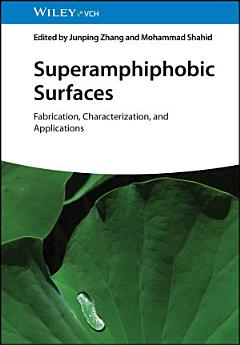Superamphiphobic Surfaces: Fabrication, Characterization, and Applications
About this ebook
Superamphiphobic Surfaces: Fabrication, Characterization, and Applications addresses a critical knowledge gap in the field of superamphiphobic surfaces, a class of materials with the extraordinary ability to repel water, oil, and other liquids, by both exploring their fundamentals and also offering detailed insights into their fabrication techniques, characterization methods, and durability considerations. The book presents practical applications of superamphiphobic surfaces in self-cleaning, anti-fouling, environmental clean-up, biomedicine, and food packaging and processing.
The book is divided into five parts. Part I lays the foundation for understanding superamphiphobic surfaces by introducing the fundamental principles that govern their behavior. Part II discusses the fabrication techniques developed to produce superamphiphobic surfaces with varying complexity, durability, and functionality. Part III provides guidelines to evaluate the performance of superamphiphobic surfaces. Part IV highlights several key areas where these surfaces are already being applied. Part V addresses the current challenges and prospects of superamphiphobic surfaces.
Written by an experienced team of researchers, Superamphiphobic Surfaces covers sample topics such as:
- The increased level of sophistication required to achieve superoleophobicity, particularly for liquids with low surface tension
- Contact angle hysteresis, wetting regimes, and the role of micro- and nanoscale structures in achieving extreme liquid repellency
- Specific challenges associated with scaling up fabrication techniques in industrial applications
- Performance criteria including mechanical durability, resistance to liquid impalement, and self-healing capabilities
- The lifespan of various materials in harsh environments such as oil rigs, pipelines, and marine vessels
Empowering readers with knowledge to drive innovation, solve practical problems, and enhance their expertise, Superamphiphobic Surfaces is an essential reference for researchers and professionals in materials science, healthcare, environmental protection, and other fields.
About the author
Junping Zhang, PhD, is Professor at the Lanzhou Institute of Chemical Physics (LICP), Chinese Academy of Sciences (CAS). His research interests include the preparation and applications of functional coatings and 3D porous materials with superwettability based on silanes and silicates.
Mohammad Shahid, PhD, is Assistant Professor in the Department of Chemistry at Koneru Lakshmaiah Education Foundation (KLEF) in Vaddeswaram, India. His research interests focus on biomaterials, functional textiles, and surfaces.







